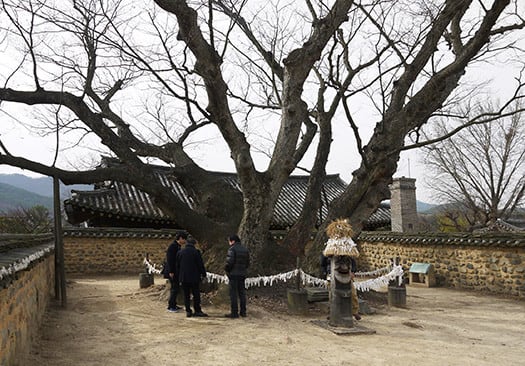

韓国・河回村(ハフェマウル)に来て最初に民俗にリスペクトして宗教的空間へ。
これは『三神堂神木』と呼ばれる樹齢600年の欅(けやき)の大木であり、
村の中央に位置し子供を授け、子供の出産と成長を助けると伝承されている。
村の神木であり毎年、最初の満月の日(デボルム)に村の平安を祈願する
ドンチェ(洞祭:村祭り)が行われてそうです。
日本には神社という独特の尊崇空間がありますが、
そのような存在は韓国・朝鮮にはないとされる。その後の中華文明である
儒教を持って国の根幹を形成しているようにエトランゼとしては思える。
そういう在地信仰として巨木には日本も自然にあるともいえる。
ケヤキの神と言うと大坂・岸和田のダンジリの歌にもあるようです。
古代応神天皇の河内王朝と伽耶国(洛東江流域)との関係・繋がりを妄想する。
また歴史の浅い北海道神宮境内ですら、結界マーキングしている自然巨木がある。
で、写真のように白い短冊状の紙が紐に付けられている。
日本の場合にはこのような場合には「注連縄」が巻かれるけれど、
一方で村の入口で出迎えてくれた仮面彫像が「よく来たな(笑)」と微笑んでいる。
入口での彫像に加えて頭部にはワラの帽子を被っている。
このワラの帽子が日本の注連縄と繋がるのかどうか、興味をそそる。
この三神堂神木はずっと通路を囲んでいる土塀に囲まれた中央広場空間。
案内説明では、ハフェマウルに建てられる住宅群はこの神木に対して
方位を向けて建てられているとされるけれど、そこまで確認する術はなかった。

上空写真と地図を組み合わせてみましたが、三神堂神木が集落の中心であることが
視覚的にもわかりやすい(韓国公的機関公開の空撮・地図のマーク箇所)。
この仮面彫像も一種の宗教的存在であることはあきらかだけれど、
これらは仮面劇でいろいろなキャラクターが存在するとされる。
その仮面劇を体験することはできなかった。日本での伎楽・雅楽的なものが
そのまま在地神化しているものと思われました。
日本の結界感覚と似ているようでかなり相違する、不思議な感覚。
逆に日本の神道や神社は非常に独特で他のアジアでは類例がないと思える。
周囲を囲む土塀は一貫してこのスタイルが踏襲されている。
沖縄の離島集落でもほぼ同様な通路と琉球石灰石での塀の連続を見たけれど、
ここでは瓦で屋根も付けられていました。
また基本は土塀ですが、石が表面に貼り付けられている様子がわかる。
土面と共通する色彩感覚なのでこの土地の土が加工されていることが伝わる。
このアースカラーには圧倒的な土地のパワーを感じさせられます。
建築は地域の材料を使って作られるので、ここでは土塗りが基本ということを
この土塀は語ってくれているものでしょう。
この地の民俗の基本がまっすぐに伝わってくる空間だと思います。
English version⬇
[Recollection of "HahoeMauru", a worship of the three shrines and giant trees-4]
When I came to Andong Hahoe Village, South Korea, I first respected the folk and went to a religious space.
This is a 600-year-old zelkova tree called "Sanjindo Shinboku".
Located in the center of the village, it is said to give birth to children and help their children give birth and grow.
It is a sacred tree of the village and prays for the peace of the village every year on the first full moon day (Deborm).
It seems that Dongche (dong festival: village festival) is being held.
Japan has a unique revered space called a shrine,
It is said that there is no such existence in Korea. The subsequent Chinese civilization
It seems to Etranze that it forms the basis of the country with Confucianism.
It can be said that Japan is naturally present in giant trees as such a local belief.
The god of zelkova seems to be in the song of Danjiri in Osaka and Kishiwada.
Delusion of the relationship and connection between the Kawachi dynasty of the ancient Emperor Ojin and Gaya (Rakuto River basin).
Even in the precincts of Hokkaido Jingu Shrine, which has a short history, there are giant natural trees that are marked with barriers.
Then, as shown in the photo, a white strip of paper is attached to the string.
In the case of Japan, "Shimenawa" is wrapped in such cases,
On the other hand, the masked statue that greeted me at the entrance of the village smiled, "I often came (laughs)."
In addition to the statue at the entrance, he wears a straw hat on his head.
It is intriguing whether this straw hat is connected to Japanese Shimenawa.
This Sanjindo Kamiki is a central plaza space surrounded by earthen walls that surround the passage all the time.
According to the guide, the houses built in Hafemaul are against this sacred tree.
It is said that it was built facing the direction, but there was no way to confirm it.
I tried to combine the aerial photograph and the map, but it is said that Sanjindo Kamiki is the center of the village
Easy to understand visually (Aerial view / map mark part published by Korean public institution).
It is clear that this masked statue is also a kind of religious entity,
These are masques and it is said that there are various characters.
I couldn't experience the masque. Gigaku and gagaku in Japan
It seemed that it had become a local deity as it was.
A mysterious sensation that seems to be similar to the Japanese barrier sensation but quite different.
On the contrary, Japanese Shinto and shrines are very unique and seem to be unique in other Asian countries.
This style is consistently followed for the surrounding earthen walls.
I saw a series of fences made of Ryukyu limestone with almost the same passages in the remote island villages of Okinawa.
The roof was also covered with tiles here.
Also, although the basic is an earthen wall, you can see how the stones are stuck on the surface.
Since it has the same color sense as the soil surface, it can be said that the soil of this land is processed.
This earth tone makes you feel the overwhelming power of the land.
Since the architecture is made using local materials, the basic idea here is to paint with soil.
This earthen wall will tell you.
I think it is a space where the basics of the folk customs of this area can be conveyed straight through.










